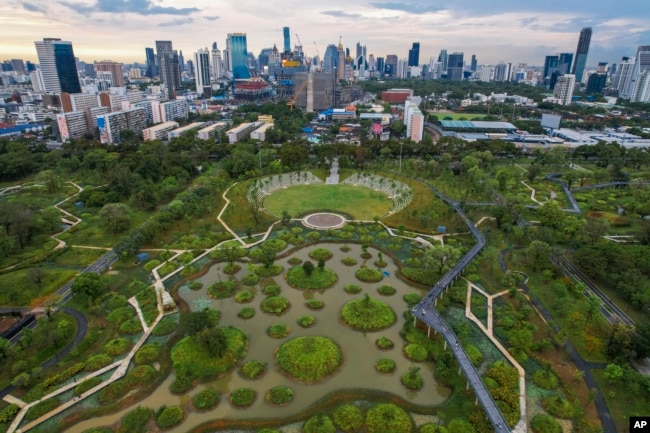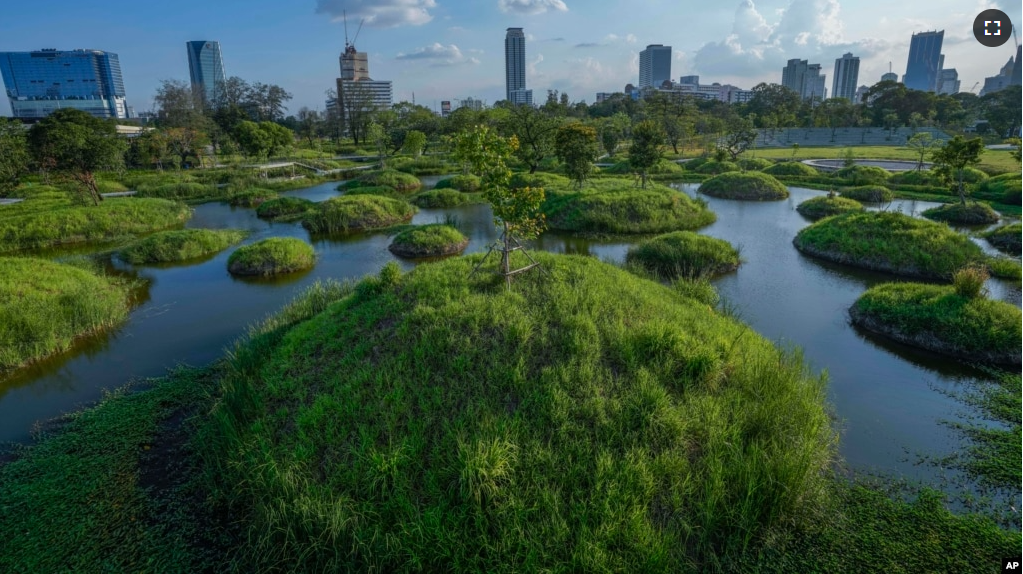People in Thailand’s capital Bangkok are enjoying a new park full of trees, water, plants and birds. Every day, crowds visit Benjakitti Forest Park to get a taste of nature in the heart of the city.
The new park is part of an effort to create a greener, more livable Bangkok by 2030.
Another park next to the site was built in the 1990s, with a large man-made lake. But the new 41-hectare extension has captured the capital’s imagination. On weekends, up to 12,000 people a day use its nature trail, walkways and bike paths.
The park used to be home to factories operated by the country’s state-run tobacco industry. Changes on the new park began several years ago. Visitors are now enjoying the park ahead of its official opening, planned for August.
“I love it,” said 44-year-old music teacher Luckachai Krichnoi. “I love the outdoors and fresh air. Bangkok does not have that many big parks. I am glad we have this beautiful space.”
The design mixes the old with the new. Designers kept more than 1,700 of the site’s original trees, then planted almost 7,000 new ones. As they age, the trees’ leaves will grow and spread, deepening the park’s cover.

The area is already popular with nature-lovers such as bird-watcher and photographer Somsak Jaitrong, who said he visits almost every day. He says he has seen more than 40 kinds of birds so far, though others have counted many more.
“The way they designed the park is quite special because they put all kinds of trees here,” he said. “You know, the birds go where the food is…”
Water plays a central part in the park. Small bodies of water, called ponds, and islands create a wildlife-friendly environment. The park’s water system also helps clean wastewater from nearby communities.
One of the park’s designers noted that a major goal was to improve people’s relationships with the natural world.
The landscape architect, Chatchanin Sung, said the green area can be more than just a place for running and other kinds of exercise. It can also increase awareness about the environment and demonstrate the importance of linking living with nature.
Bangkok is mostly surrounded by concrete and steel. Officials have estimated the city’s population currently enjoys just 7 square meters of green space per person.
The aim is to increase that to 10 square meters by 2030 through a park-building program and by planting more trees.
But Bangkok’s real problem, one expert argues, is not the average amount of available green space. A big concern is also how much green space is spread throughout the city. The new park demonstrates that point.
“Benjakitti Park (is) located in the area where the green area per capita is much higher than other areas. … the park is very nice, very beautiful, I love it, but how about other districts?” said Niramon Serisakul. She is the director of Chulalongkorn University’s Urban Design and Development Center.
Six kilometers from Benjakitti’s beautiful surroundings, another green area stretches across Bangkok’s Chao Phraya River. At sunset, the area offers large views and a cool breeze.
The 280-meter-long Chao Phraya Sky Park was created two years ago from a bridge that was built but never used. Niramon says Bangkok needs to create more of these kinds of areas to expand the amount of green space in the city in a more equal way.
I’m John Russell.
Jerry Harmer and Tassanee Vejpongsa reported on this story for the Associated Press. John Russell adapted it for VOA Learning English.
________________________________________________________________________
Words in This Story
extension – n. something (such as an interest or activity) that develops from something else
original – adj. existing from the beginning, or being the earliest form of something
landscape – n. an area of land that has a particular quality or appearance
architect – n. a person who designs and guides a plan, project, etc.
per capita – adv. by or for each person
breeze – n. a soft wind
